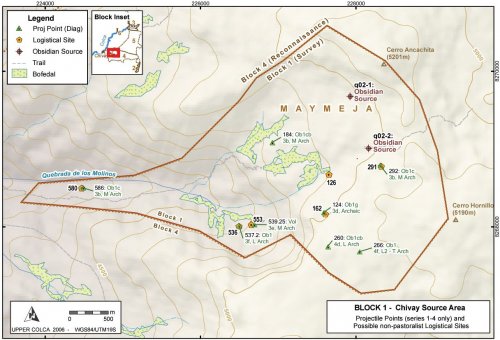The Archaic Forager sites in Block 1
In the Maymeja portion of the Chivay source all surface archaeological materials diagnostic to time periods prior to pastoralism belonged to multicomponent sites with a substantial pastoralist component. This settlement pattern reflects the exposed, windy nature of the Chivay source: all sheltered areas that may have had overnight occupation were reused. No sites that could be termed "residential bases", using the same criteria as the other blocks of the Upper Colca project survey, were identified in this area.
Projectile points dating to the Archaic Foragers period were located in course of the survey of Block 1. Unsurprisingly, these points were virtually all obsidian, and most appeared to have been broken during manufacture with longitudinal breaks and incomplete scar coverage. In addition, it appears that broken non-obsidian bases were occasionally abandoned at the obsidian source, perhaps in the process of reusing the haft with newly fashioned obsidian points. For example, the base of a chert point with evidence of pressure flaking [A03-122] was recovered on the southern slopes of the Maymeja area during the survey work.
Figure 6-7. Possible Chivay obsidian source camps during Archaic Forager times.
Problems with isolating Archaic Foragers sites
One of the principal problems in isolating Archaic Foragers sites is that many of the artifactual indicators used in this research to designate sites as potentially belonging to the Early, Middle, or Late Archaic are not relevant in the obsidian source area. Of the three indicators that might potentially be used to designate sites from the Late Archaic or earlier, all three indicators have limitations.
(1) Aceramic sites.The use of ceramics in the high altitude obsidian source area appears to have been limited through the Formative Period (described in Section 6.4.1). Thus, the lack of ceramics is not evidence for a site dating to the preceramic.
(2) Material type ratios.A higher percentage of non-obsidian lithic material, primarily fine-grained volcanics, was used as an indicator of possible Archaic Foragers occupation in Block 3 of the survey area. This indicator doesn't apply to the obsidian source area, however, because virtually all flaked stone is obsidian in this area throughout prehistory.
(3) Diagnostic projectile points.Time sensitive projectile point styles continue to serve as indicators of temporal affiliation in the obsidian source area. However, as Block 1 consists of a lithic production area the projectile points found there were often incompletely flaked or broken during manufacture. As a result, a number of the projectile points did not belong to a particular point style.
The vast majority of scatters in the Maymeja area consisted of non-diagnostic scatters of obsidian with a high frequency of cortical flakes. It is possible that some of these scatters date to the period before the Terminal Archaic, and indeed many of these sites contain no ceramics. However, in this relatively high area remote from population centers, the fact that a site is a-ceramic cannot be taken as evidence that the site dates to the pre-ceramic. Given the intensification on obsidian production that occurred during the Terminal Archaic and onward, these non-diagnostic obsidian scatters are evaluated here as by-products of pastoral period intensification in the area.
